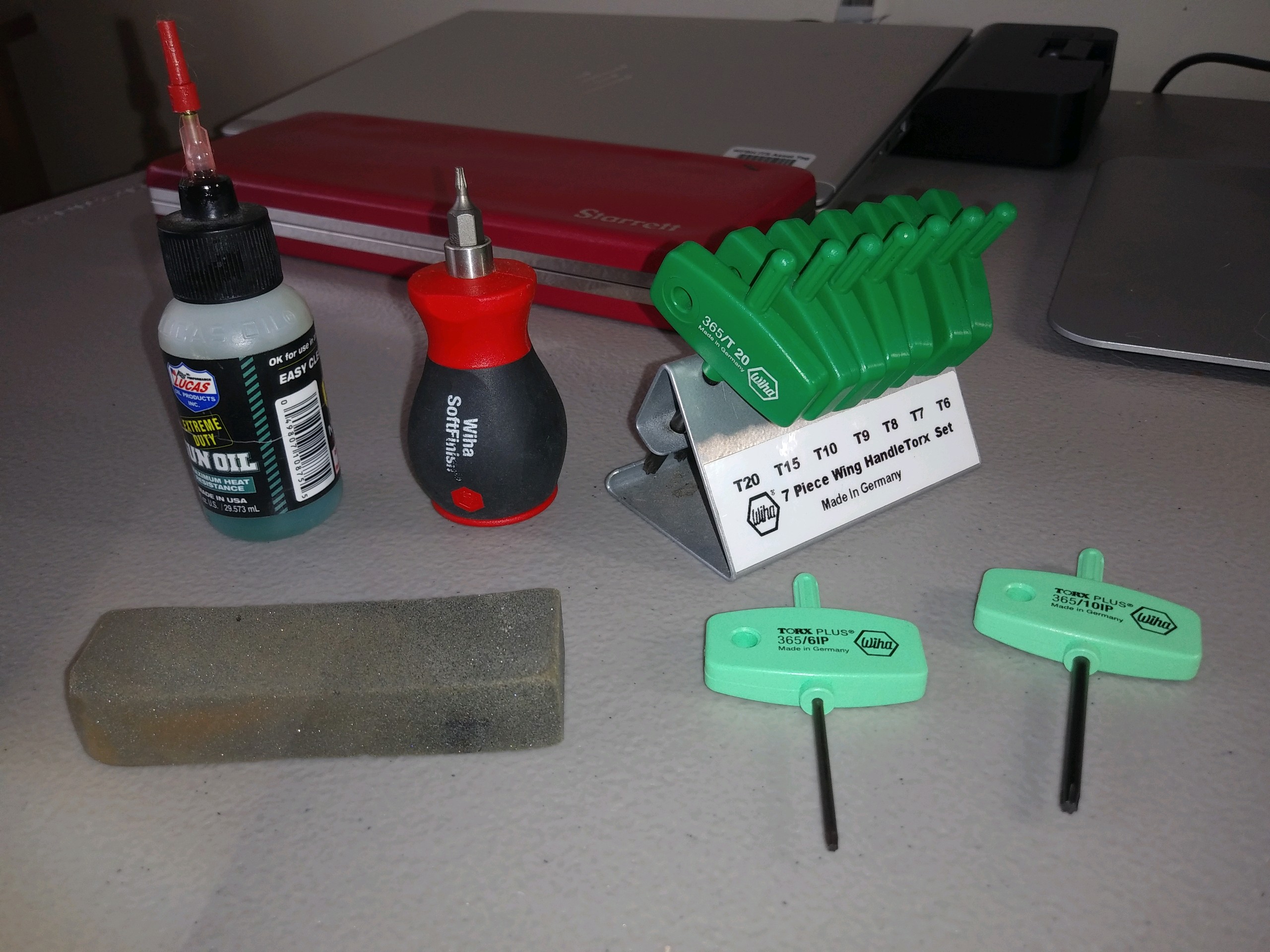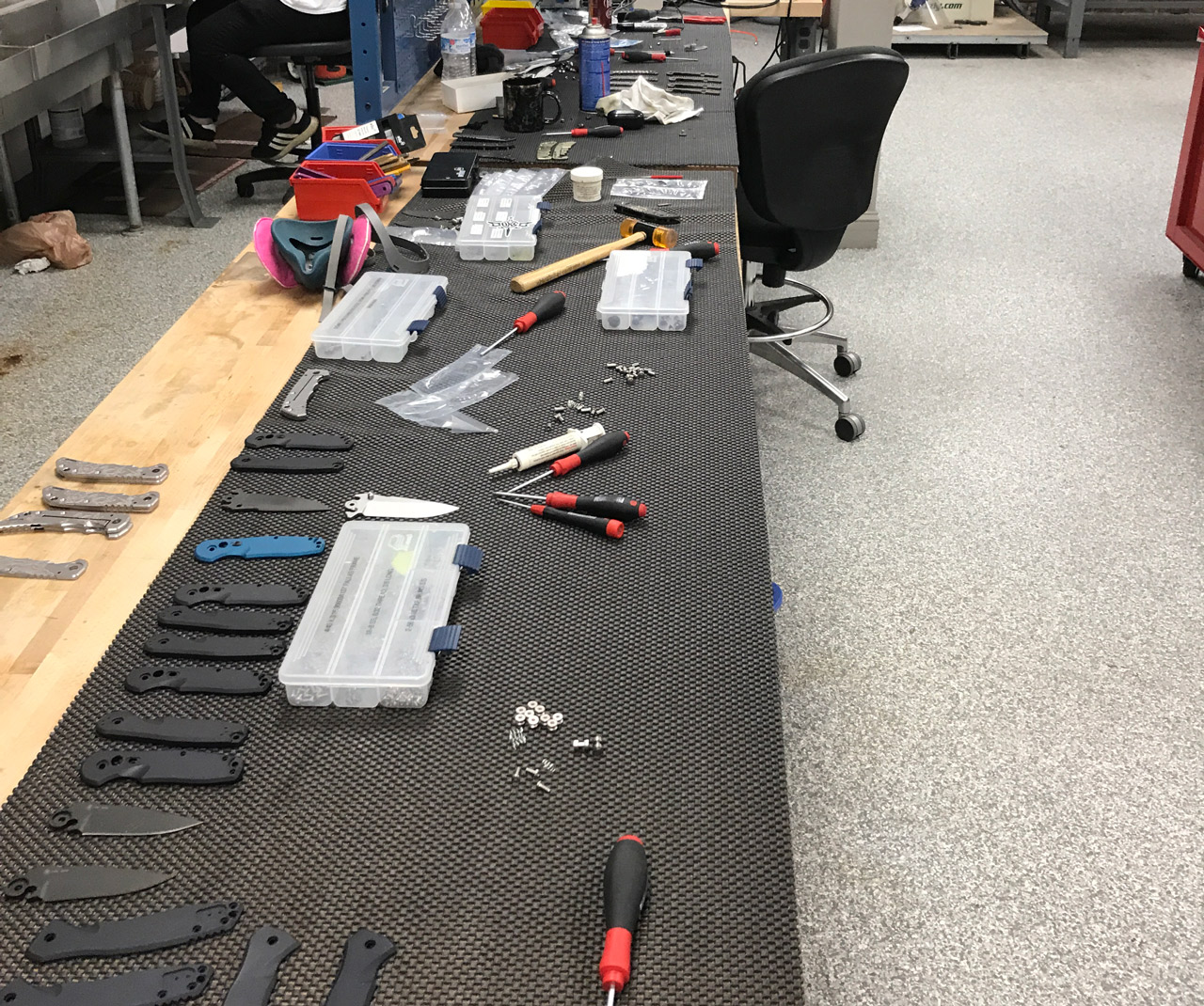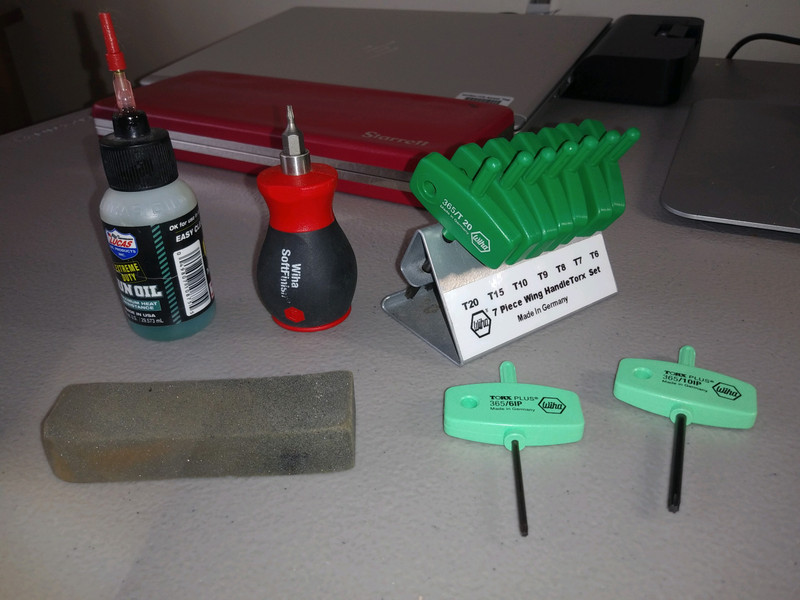If you have ever been into knives for any length of time, you are aware that when you own knives, you also have a need to own knife-specific tools as well. For instance - when your pocket clip comes loose, or when you need to re-adjust pivot tension on a folder, or even carefully take apart a folder for thorough deep cleaning. What tools and supplies do you specifically need to keep around to address knife maintenance/adjustment issues? If you travel at all with folding knives - be it on vacation or a camping trip - it’s advisable to take along some basic tools just in case. So, a prudent knife nut would carry along a compact sharpener, as well as some of these tools to address minor issues that come up with folding knives at times, from loose pivots to loose clips and everything else in between. You never know when little emergencies crop up and when they do you want to be prepared to handle them. Here’s what I have managed to accumulate for my own knife-specific tools and supplies, hope this will be of help to you in getting yours together, or augmenting what you have already.
When it comes to folding knives, most tactical folders are of screw-together handle construction that also includes an adjustable pivot as well. Even if your knife may not have assembly screws or an adjustable pivot - at best you’ll also have a pocket clip that’s held on by small screws. Most knives today use the Torx style screws. You’ll find various sizes even on one knife, and this also depends on the manufacturer or custom maker. For instance, the pivot screw maybe either a T8 or T10. Handle assembly screws maybe T6 or T8, and pocket clip screws are always T6. You can buy individual Torx drivers and these will serve you well but I find that the precision screwdriver ones you find sold at hardware stores and home centers offer the best in value and convenience. For example, the Husky 8-in-1 Precision Torx Screwdriver St, sold at Home Depot for about $6. You get multiple sizes of interchangeable Torx bits, ranging from T4 all the way to T15. The bits store inside the hollow handle and there’s a rotating cap at the top for precise movements. Lowes Home Improvement sells something similar with their Kobalt 14 piece Multi-Bit Screwdriver Set, which is slightly more at around $10. There’s no indication on the Lowes’ website on what bit sizes are included in this one. Look on the packaging and make sure that it has T6, T8, and T10 sizes. The three most common sizes used in folding knives. A caveat here, with the T6 size in these cheaper sets. I’ve owned both the Husky and Kobalt drivers and the T6 WILL end up snapping at some point. These are small size drivers and repeated tightening and loosening torque will eventually weaken the metal. If you don’t tinker with your knives a whole lot then you can probably get by with these. I actually got tired of repeatedly snapping off T6’s so I eventually spent close to $50 for a really nice set of wing handle Torx drivers made by Wiha. Wiha is a German brand of hand tools, very good stuff. They are more expensive than what you find in home centers but in the end the prices are worth it because you get a better engineered tool that can withstand repeated heavy use. I do not regret this purchase. Even years later, the T6 driver that’s a part of this set is the ORIGINAL one that came with it. In other words, I’ve yet to break a Wiha. Consider making this investment if you will be using your drivers quite a bit. Plus, the wing handles allow you to exert more torque than the aforementioned multi-bit screwdrivers above.

A picture of the author knife care kit
The next tool that any knife enthusiast should have is what is called an Eraser Block. It’s an abrasive type eraser that has alumina ceramic particles mixed in. It somewhat resembles an eraser that you would buy at an office supply store. Instead of erasing pencil lead, this Eraser Block is a great tool to use to remove light surface rust off of satin finished blades. What you do is firmly hold the knife handle with one hand and with the Eraser Block in the other, lightly rub away the rust spots, rubbing in the same direction as the factory satin finish marks. There is no need to apply heavy pressure, as the alumina ceramic particles do the work for you. The corners of the block are great for precise work, but usually you would use the edge of one of the ends to rub on the blade. If you use ceramic crock sticks or any other type ceramic sharpener, you notice how the ceramic rods get coated with the fines of the steel, as the are eroded off. The Eraser Block works well as removing those deposits from the ceramic sharpener. No water needed, no chemicals needed. Easy to use! SMKW sells the Lansky Eraser Block for $5.99, and one block will last you seemingly, forever. I’ve had my Eraser Block for maybe over 10 years now and it still mostly the same size as it was when new. This product works well with removing rust spots as well from tools - screwdrivers, pliers, putty knives, wrenches, etc. So no doubt you will also find other non-knife uses for it. Keep in mind that this is an abrasive and will scratch plastic, phenolics, and mirror polished finishes.
Getting back to folding knives, you have an adjustable pivot as found on every tactical folder and some lockbacks as well. Sometimes the pivot adjustments work their way loose and there’s excessive lateral blade play. Well, take your Torx driver and tighten it back up to desired tension. Eventually it will loosen again. To prevent it from loosening or possibly backing all the way out and you risk losing the screw entirely, get a tube of thread lock compound at the hardware store. You’ll find these generally in the same aisle you would find all your adhesives. There are several manufacturers that make thread lock compounds, Permatex is one and Loc-Tite is another. There are also different grades of thread lock compound as well. Be sure to select the BLUE grade. Blue will bind the screw from loosening due to vibration or light rotation but it will also allow you to loosen the screw with some force to overcome the adhesion. DO NOT use red or white! Those are stronger adhesives and you could run the risk of stripping out the screw head trying to overcome the adhesion. Not much is needed for any knife screw - just one small drop is all you need. Not only can you secure the pivot screw but also pocket clip screws as well. One tube should last you indefinitely, though, I have found if the thread lock is too old it loses its adhesion characteristics so you’ll need to replace the tube once every few years or so. Still, at this rate you won’t even use ¼ of it, but it’s still a necessary item to have in your knife toolbox. It will save headaches of continuously loosening pivots!
Another item that is handy to have in this toolbox is some paracord. Preferably, some bright colored paracord, such as orange, tan, or even fluorescent yellow. If you do work with fixed blades, you might want to thread a lanyard through the lanyard hole in the handle to prevent accidental dropping of the knife when you are working at height or over or around water. The reason for the bright colored paracord is, if you have all-black fixed blades as you’ll find in a lot of tactical knives, having a bright colored lanyard makes the knife easy to spot if you accidentally drop it amongst vegetation or on leaf-covered ground. If you’re the sort that likes to carry skeletonized handle fixed blades, sometimes you might want to wrap the handle with paracord to provide a more comfortable grip. I wouldn’t recommend using a bright colored paracord but something like black, tan, or maybe even camo paracord. Plus, paracord is also good for other uses in case you need to tie something (or someone….HAHA just kidding) up in a pinch - use some paracord. You’ll find bunches of paracord for sale cheap at Army Navy surplus stores or even some hardware stores so you might want to raid places like these to see about getting the best deals. Don’t forget to have a lighter as well, to melt the ends of the paracord so it doesn’t fray.

Several Wiha tool on the assembly bench at Spartan Blades
If you have any sort of folding knives in your collection, then it is very important to have a bottle of some sort of lubricant to keep the pivots on your knives functioning smoothly. There’s a wide variety of lube available on the market, and there’s plenty of information on the internet about them as well. So, be sure to do your research and choose the lube that best suits your needs. There’s a lot of great choices as far as lube goes, and it could be to the point where making a choice is difficult. I won’t make any specific recommendations as far as this goes. I will say that in general, any lube that you would use with firearms is great to use with knives as well, so that opens up an even larger selection. Chances are good that where you live there is either a gun store and/or a large sporting goods store that sells firearms and ammunition. Gun lube is always found in places like these. So, this is a safe bet. Regardless of what you select, it’s just important to have lube as a part of your knife care toolkit.
So there, you have it. The above listed items are what I consider to be essential items in your knife care toolkit. Feel free to add other items that you need as well depending on the style of knives that you have and what materials they are made of. For instance, if you have a lot of carbon steel knives, you’ll need some sort of oil to keep a light coating on the blades to ward off moisture and prevent rust. I would also recommend buying a small toolbox to place these items in, which comes in handy because you can keep this small toolbox inside the house, away from your regular tools in the garage so you don’t have to venture to the garage every time you need to tighten your pivot or clip screws. Having the proper tools that you need to maintain your knives is just as essential as learning to sharpen your own knives.

